Analysis of the Water Quality Status and Its Historical Evolution Trend in the Mainstream and Major Tributaries of the Yellow River Basin
Abstract
1. Introduction
2. Materials and Methods
2.1. Study Area
2.2. Methodology
3. Results
3.1. Water Quality in the Yellow River Basin
3.1.1. Water Usage, Wastewater Discharge, and Pollutant Emissions in the Yellow River Basin
3.1.2. Classification of Overall Water Quality in the Yellow River Basin
3.2. Water Quality in the Yellow River Mainstream
3.2.1. Classification of Overall Water Quality in the Yellow River Mainstream
3.2.2. Pollutant Concentrations in the Yellow River Mainstream
3.3. Water Quality of Major Tributaries in the Yellow River
3.3.1. Classification of Overall Water Quality in the Yellow River Tributaries
3.3.2. Pollutant Concentrations in the Yellow River Tributaries
3.4. Variations in Water Quality in the Huayuankou Section
4. Discussion
4.1. Water Quality in the Yellow River Basin, Mainstream, and Tributaries
4.2. Water Quality in the Huayuankou Section
5. Conclusions
Supplementary Materials
Author Contributions
Funding
Data Availability Statement
Conflicts of Interest
References
- Xia, J.; Jiang, Q.; Deng, S.; Zhou, M.; Cheng, Y.; Li, Z.; Wang, Z. Morphological characteristics and evolution processes of sharp bends in the Lower Yellow River. Catena 2022, 210, 105936. [Google Scholar] [CrossRef]
- Chen, Y.P.; Fu, B.J.; Zhao, Y.; Wang, K.B.; Zhao, M.M.; Ma, J.F.; Wu, J.H.; Xu, C.; Liu, W.G.; Wang, H. Sustainable development in the Yellow River Basin: Issues and strategies. J. Clean. Prod. 2020, 263, 121223. [Google Scholar] [CrossRef]
- Yin, L.; Feng, X.; Fu, B.; Wang, S.; Wang, X.; Chen, Y.; Tao, F.; Hu, J. A coupled human-natural system analysis of water yield in the Yellow River basin, China. Sci. Total Environ. 2021, 762, 143141. [Google Scholar] [CrossRef]
- Wang, G.; Zhang, J.; Jin, J.; Weinberg, J.; Bao, Z.; Liu, C.; Liu, Y.; Yan, X.; Song, X.; Zhai, R. Impacts of climate change on water resources in the Yellow River basin and identification of global adaptation strategies. Mitig. Adapt. Strateg. Glob. Change 2017, 22, 67–83. [Google Scholar] [CrossRef]
- Feng, Y.; Zhu, A. Spatiotemporal differentiation and driving patterns of water utilization intensity in Yellow River Basin of China: Comprehensive perspective on the water quantity and quality. J. Clean. Prod. 2022, 369, 133395. [Google Scholar] [CrossRef]
- Chang, J.; Li, Y.; Yuan, M.; Wang, Y. Efficiency evaluation of hydropower station operation: A case study of Longyangxia station in the Yellow River, China. Energy 2017, 135, 23–31. [Google Scholar] [CrossRef]
- Si, Y.; Li, X.; Yin, D.; Liu, R.; Wei, J.; Huang, Y.; Li, T.; Liu, J.; Gu, S.; Wang, G.; et al. Evaluating and optimizing the operation of the hydropower system in the Upper Yellow River: A general LINGO-based integrated framework. PLoS ONE 2018, 13, e0191483. [Google Scholar] [CrossRef] [PubMed]
- Zhang, W.; Liang, W.; Gao, X.; Li, J.; Zhao, X. Trajectory in water scarcity and potential water savings benefits in the Yellow River basin. J. Hydrol. 2024, 633, 130998. [Google Scholar] [CrossRef]
- Zhang, Y.; Zhao, Z.; Fu, B.; Ma, R.; Yang, Y.; Lü, Y.; Wu, X. Identifying ecological security patterns based on the supply, demand and sensitivity of ecosystem service: A case study in the Yellow River Basin, China. J. Environ. Manag. 2022, 315, 115158. [Google Scholar] [CrossRef]
- Yu, S.-Y.; Li, W.-J.; Zhou, L.; Yu, X.; Zhang, Q.; Shen, Z. Human Disturbances Dominated the Unprecedentedly High Frequency of Yellow River Flood over the Last Millennium. Sci. Adv. 2023, 9, eadf8576. [Google Scholar] [CrossRef]
- Quan, J.; Xu, Y.; Ma, T.; Wilson, J.P.; Zhao, N.; Ni, Y. Improving surface water quality of the Yellow River Basin due to anthropogenic changes. Sci. Total Environ. 2022, 836, 155607. [Google Scholar] [CrossRef] [PubMed]
- Jiang, L.; Zuo, Q.; Ma, J.; Zhang, Z. Evaluation and prediction of the level of high-quality development: A case study of the Yellow River Basin, China. Ecol. Indic. 2021, 129, 107994. [Google Scholar] [CrossRef]
- Zhang, M.; Wang, X.; Liu, C.; Lu, J.; Qin, Y.; Mo, Y.; Xiao, P.; Liu, Y. Identification of the heavy metal pollution sources in the rhizosphere soil of farmland irrigated by the Yellow River using PMF analysis combined with multiple analysis methods—Using Zhongwei city, Ningxia, as an example. Environ. Sci. Pollut. Res. 2020, 27, 16203–16214. [Google Scholar] [CrossRef] [PubMed]
- Wu, N.; Liu, S.M.; Zhang, G.L.; Zhang, H.M. Anthropogenic impacts on nutrient variability in the lower Yellow River. Sci. Total Environ. 2021, 755, 142488. [Google Scholar] [CrossRef]
- Ministry of Ecology and Environment of People’s Republic of China, Action Plan for Prevention and Control of Water Pollution. Available online: https://english.mee.gov.cn/News_service/news_release/201504/t20150427_299595.shtml#:~:text=The%20action%20plan%20proposed%20that,level%2C%20the%20overexploitation%20of%20groundwater (accessed on 5 June 2024).
- Zhou, Y.; Ma, J.; Zhang, Y.; Qin, B.; Jeppesen, E.; Shi, K.; Brookes, J.D.; Spencer, R.G.M.; Zhu, G.; Gao, G. Improving water quality in China: Environmental investment pays dividends. Water Res. 2017, 118, 152–159. [Google Scholar] [CrossRef]
- Liu, S.; Qiu, Y.; Fu, R.; Liu, Y.; Suo, C. Identifying the water quality variation characteristics and their main driving factors from 2008 to 2020 in the Yellow River Basin, China. Environ. Sci. Pollut. Res. 2023, 30, 66753–66766. [Google Scholar] [CrossRef]
- Sun, X.; Zhou, Z.; Wang, Y. Water resource carrying capacity and obstacle factors in the Yellow River basin based on the RBF neural network model. Environ. Sci. Pollut. Res. 2023, 30, 22743–22759. [Google Scholar] [CrossRef]
- Liu, T.; Wang, F.; Michalski, G.; Xia, X.; Liu, S. Using 15N, 17O, and 18O to determine nitrate sources in the Yellow River, China. Environ. Sci. Technol. 2013, 47, 13412–13421. [Google Scholar] [CrossRef]
- Li, B.; Feng, Q.; Wang, X.; Li, Z.; Wang, F.; Zhao, C.; Yu, T.; Chen, W. Formation of the upper reaches of the Yellow River: Provenance evidence from the strata of the Yellow River sedimentary basin. Glob. Planet. Change 2023, 229, 104224. [Google Scholar] [CrossRef]
- Wu, Z.; Tian, G.; Xia, Q.; Hu, H.; Li, J. Connotation, calculation and influencing factors of the water-use rights benchmark price: A case study of agricultural water use in the Ningxia Yellow River irrigation area. Agric. Water Manag. 2023, 283, 108300. [Google Scholar] [CrossRef]
- Xu, Z.; Liu, M.; Guan, G.; Guo, X. Emergency intervention modes for ice jam events in large-scale water diversion projects. Hydrol. Res. 2023, 54, 1134–1151. [Google Scholar] [CrossRef]
- Wu, X.; Wei, Y.; Fu, B.; Wang, S.; Zhao, Y.; Moran, E.F. Evolution and Effects of the Social-Ecological System over a Millennium in China’s Loess Plateau. 2020. Available online: https://www.science.org/doi/full/10.1126/sciadv.abc0276 (accessed on 8 June 2024).
- Pan, B.; Hu, Z.; Wang, J.; Vandenberghe, J.; Hu, X.; Wen, Y.; Li, Q.; Cao, B. The approximate age of the planation surface and the incision of the Yellow River. Palaeogeogr. Palaeoclimatol. Palaeoecol. 2012, 356–357, 54–61. [Google Scholar] [CrossRef]
- Kong, D.; Miao, C.; Li, J.; Zheng, H. Full-stream erosion in the lower Yellow River: Feasibility, sustainability and opportunity. Sci. Total Environ. 2022, 807, 150810. [Google Scholar] [CrossRef]
- Zhou, Y.; Huang, H.Q.; Ran, L.; Shi, C.; Su, T. Hydrological controls on the evolution of the Yellow River Delta: An evaluation of the relationship since the Xiaolangdi Reservoir became fully operational. Hydrol. Process. 2018, 32, 3633–3649. [Google Scholar] [CrossRef]
- He, H.; Yu, Q.; Zhou, J.; Tian, Y.Q.; Chen, R.F. Modelling complex flood flow evolution in the middle Yellow River basin, China. J. Hydrol. 2008, 353, 76–92. [Google Scholar] [CrossRef]
- Gippel, C.; Jiang, X.; Zhang, D.; Cooling, M.; Kerr, G.; Close, P.; Jin, S.; Li, L.; Wang, Z.; Ma, Z.; et al. Environmental Flows Assessment for the Lower Yellow River. 2012. Available online: www.watercentre.org (accessed on 15 May 2024).
- Liu, W.; Shi, C.; Zhou, Y. Trends and attribution of runoff changes in the upper and middle reaches of the Yellow River in China. J. Hydro-Environ. Res. 2021, 37, 57–66. [Google Scholar] [CrossRef]
- Galler, J.J. Medium-and Long-Term Changes in Fluvial Discharge to the Sea: Medium-and Long-Term Changes in Fluvial Discharge to the Sea: The Yellow River Case Study the Yellow River Case Study. Master’s Thesis, William & Mary, Williamsburg, VA, USA, 1999. [Google Scholar] [CrossRef]
- Dai, Y.; Lu, F.; Ruan, B.; Song, X.; Du, Y.; Xu, Y. Decomposition of contribution to runoff changes and spatial differences of major tributaries in the middle reaches of the Yellow River based on the Budyko framework. Hydrol. Res. 2023, 54, 435–450. [Google Scholar] [CrossRef]
- Zhao, M.M.; Wang, S.M.; Chen, Y.P.; Wu, J.H.; Xue, L.G.; Fan, T.T. Pollution status of the Yellow River tributaries in middle and lower reaches. Sci. Total Environ. 2020, 722, 137861. [Google Scholar] [CrossRef]
- Wang, Z.C.; Zhang, S.X.; Mao, H.T.; Shen, J.W.; Guo, W.D. Analysis of Water and Sediment Characteristics of the Yellow River and Their Correlations. Pol. J. Environ. Stud. 2023, 32, 2909–2923. [Google Scholar] [CrossRef]
- Jin, F.; Yang, W.; Fu, J.; Li, Z. Effects of vegetation and climate on the changes of soil erosion in the Loess Plateau of China. Sci. Total Environ. 2021, 773, 145514. [Google Scholar] [CrossRef]
- Zhang, Y.; Chao, Y.; Fan, R.; Ren, F.; Qi, B.; Ji, K.; Xu, B. Spatial-temporal trends of rainfall erosivity and its implication for sustainable agriculture in the Wei River Basin of China. Agric. Water Manag. 2021, 245, 106557. [Google Scholar] [CrossRef]
- Storozum, M.J.; Mo, D.; Wang, H.; Ren, X.; Zhang, Y.; Kidder, T.R. Anthropogenic origins of a late Holocene, basin-wide unconformity in the middle reaches of the Yellow River, the Luoyang Basin, Henan Province, China. Quat. Res. 2017, 87, 423–441. [Google Scholar] [CrossRef]
- Lv, W.; Yang, H. Distribution of Phosphorus and Iron Species in the Sediments along the Path of Yellow River and Correlation of Contents of the Two Species. Source: J. Coast. Res. 2020, 104, 813–817. [Google Scholar] [CrossRef]
- van Maren, D.S.; Yang, M.; Wang, Z.B. Predicting the Morphodynamic Response of Silt-Laden Rivers to Water and Sediment Release from Reservoirs: Lower Yellow River, China. J. Hydraul. Eng. 2011, 137, 90–99. [Google Scholar] [CrossRef]
- Zhang, M.; Ping, J.; Mei, X.; Leng, W.; Li, H.; Zhao, J.; Liu, J. The trend of groundwater recharge in the secondary perched reaches of the Yellow River in the past 50 years. Front. Environ. Sci. 2023, 11, 1310181. [Google Scholar] [CrossRef]
- China National Environmental Monitoring Centre, National Surface Water Quality Automatic Monitoring Real-Time Database. Available online: https://szzdjc.cnemc.cn:8070/GJZ/Business/Publish/Main.html (accessed on 1 April 2024).
- GB 3838-2002; Environmental Quality Standards for Surface Water. Ministry of Ecology and Environment of People’s Republic of China: Beijing, China, 2002.
- Xu, Y.; Liu, S.; Wang, J. Impact of environmental regulation intensity on green innovation efficiency in the Yellow River Basin, China. J. Clean. Prod. 2022, 373, 133789. [Google Scholar] [CrossRef]
- Lu, C.; Ji, W.; Hou, M.; Ma, T.; Mao, J. Evaluation of efficiency and resilience of agricultural water resources system in the Yellow River Basin, China. Agric. Water Manag. 2022, 266, 107605. [Google Scholar] [CrossRef]
- Yu, J. Coordinated development of urban economy and total amount control of water environmental pollutants in the Yellow River basin. Arab. J. Geosci. 2021, 14, 658. [Google Scholar] [CrossRef]
- Du, H.; Ji, X.; Chuai, X. Spatial Differentiation and Influencing Factors of Water Pollution-Intensive Industries in the Yellow River Basin, China. Int. J. Environ. Res. Public Health 2022, 19, 497. [Google Scholar] [CrossRef]
- Liu, X.; Sheng, Y.; Liu, Q.; Li, Z. Suspended particulate matter affects the distribution and migration of heavy metals in the Yellow River. Sci. Total Environ. 2024, 912, 169537. [Google Scholar] [CrossRef]
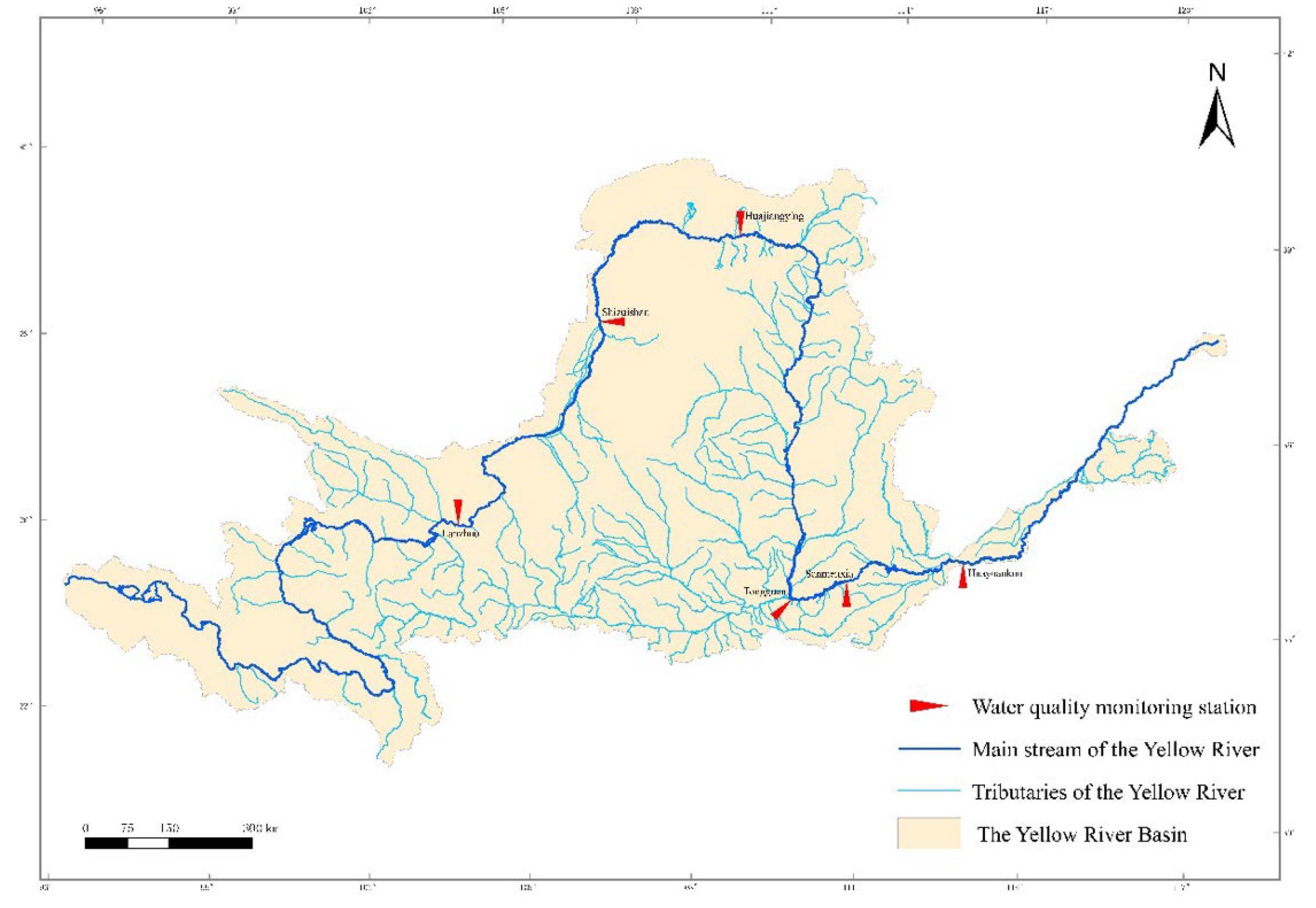
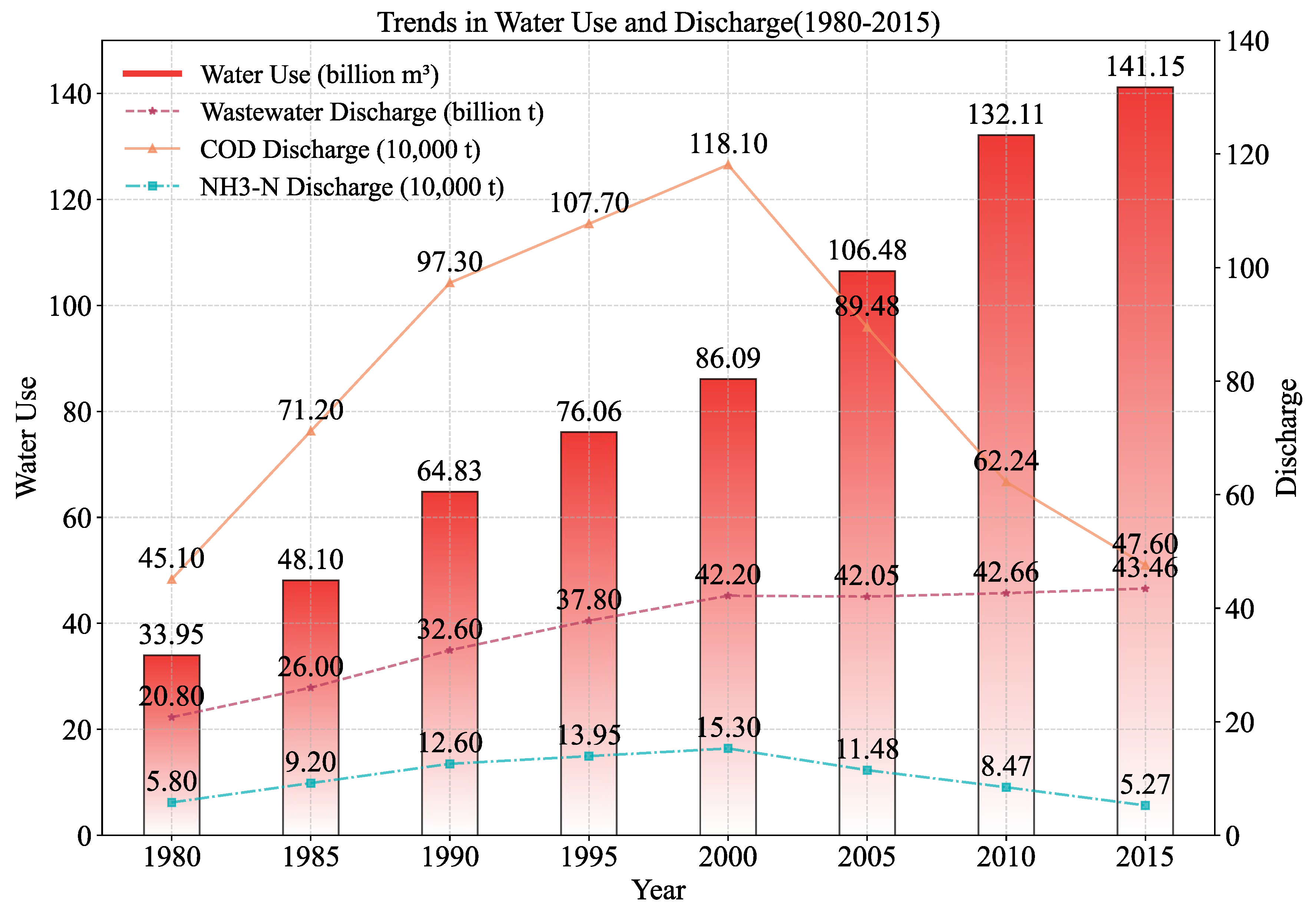

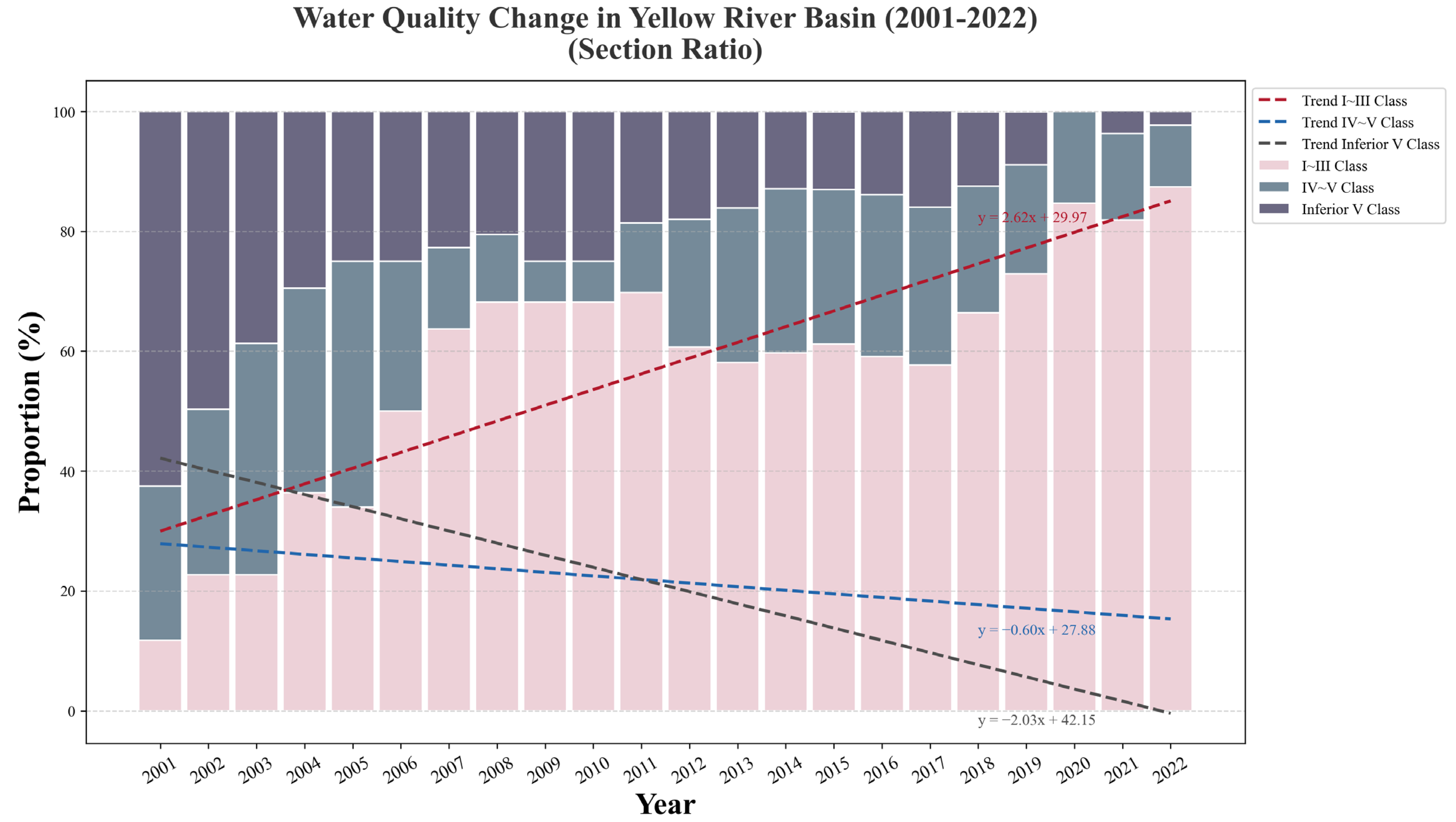
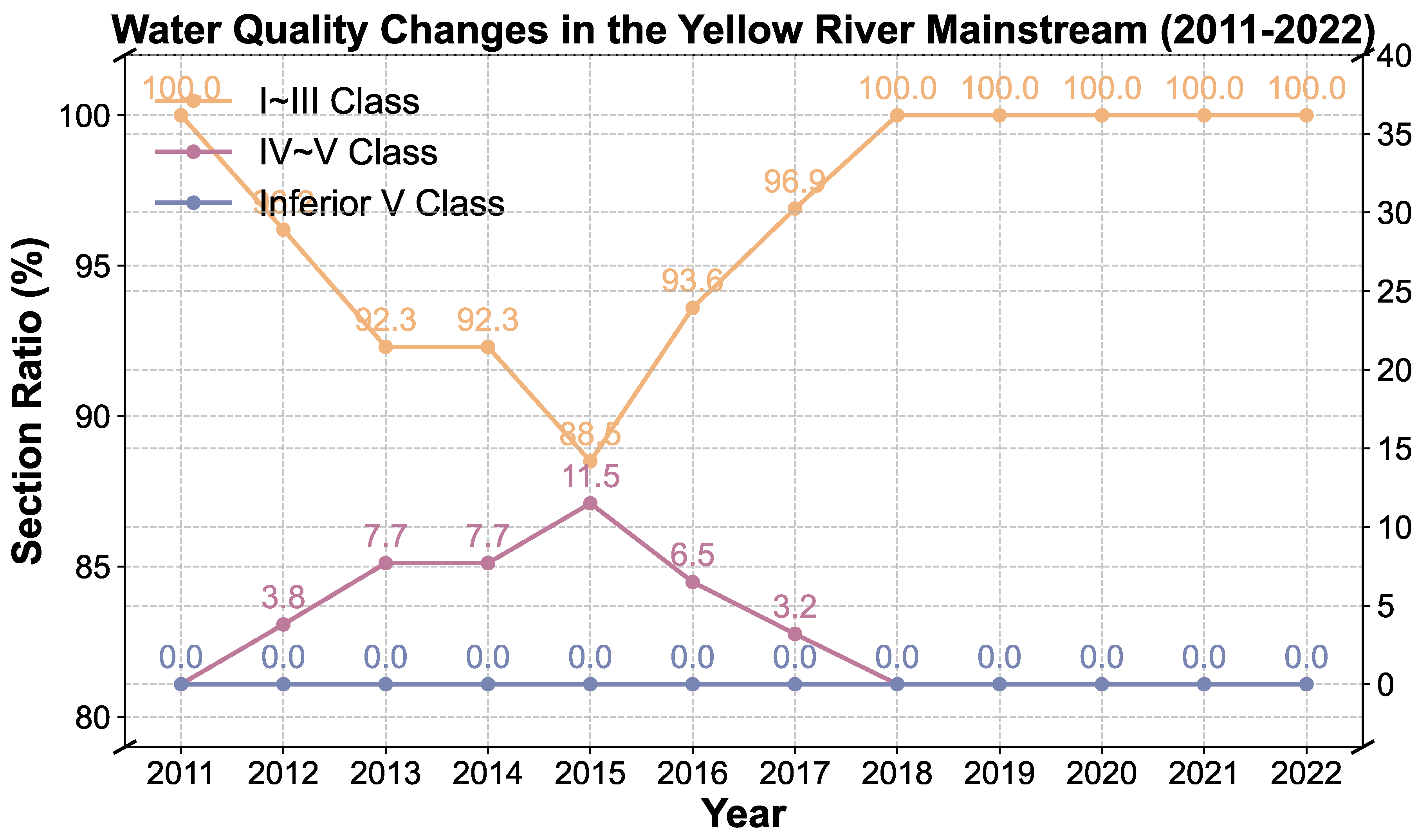
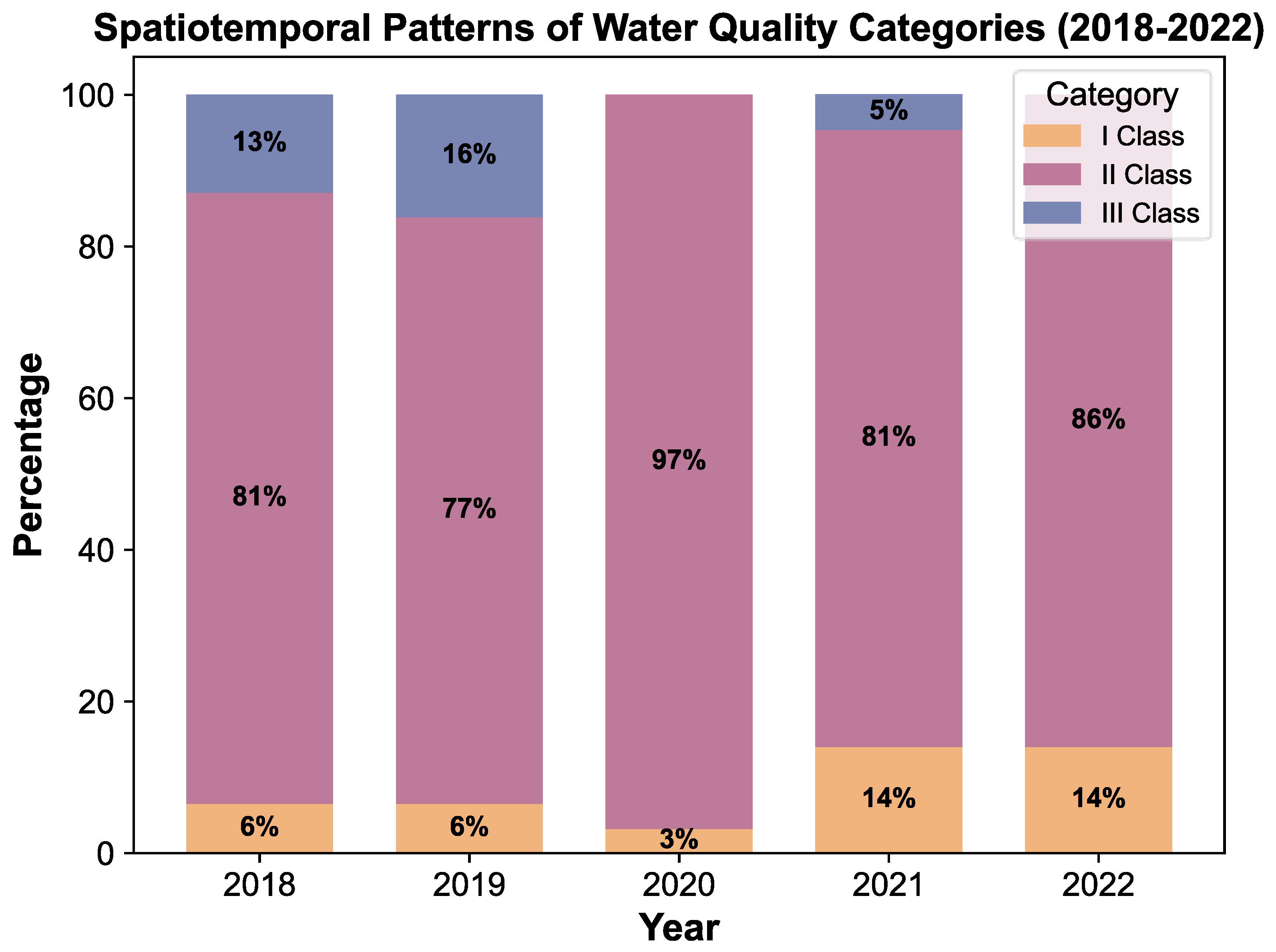


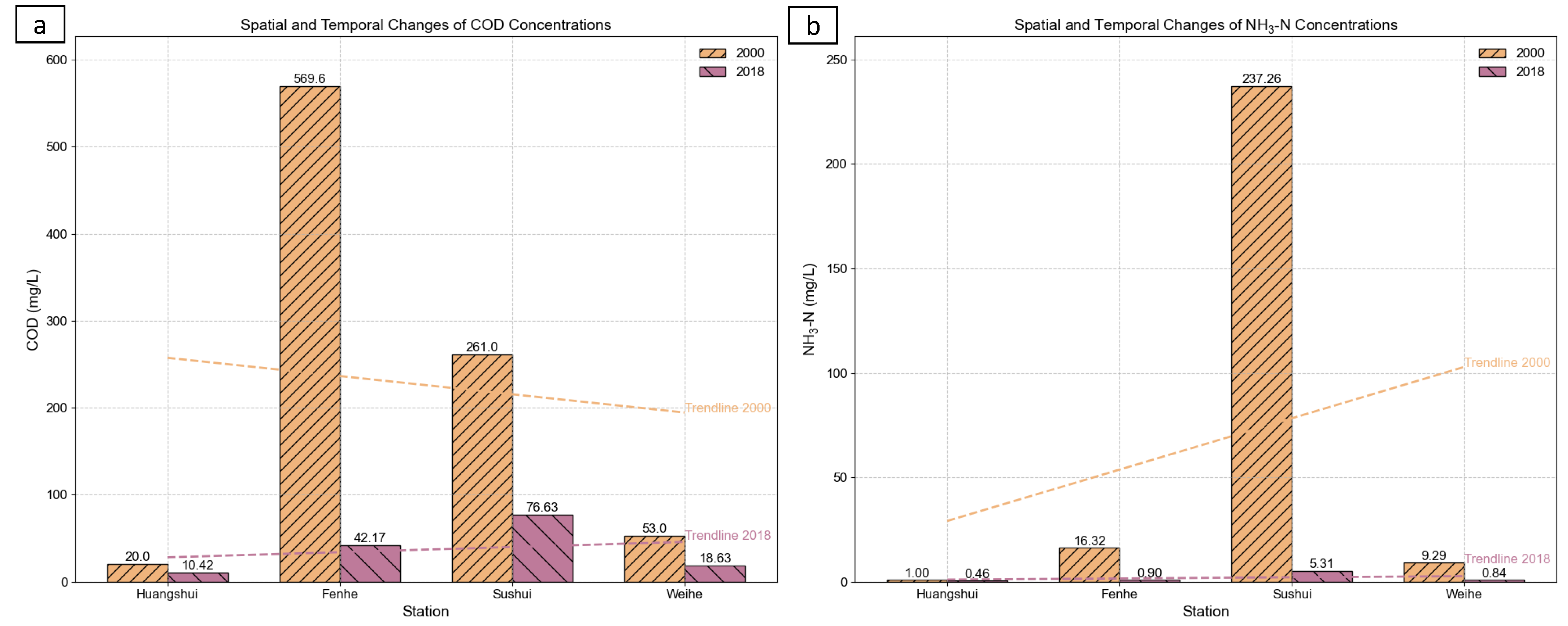
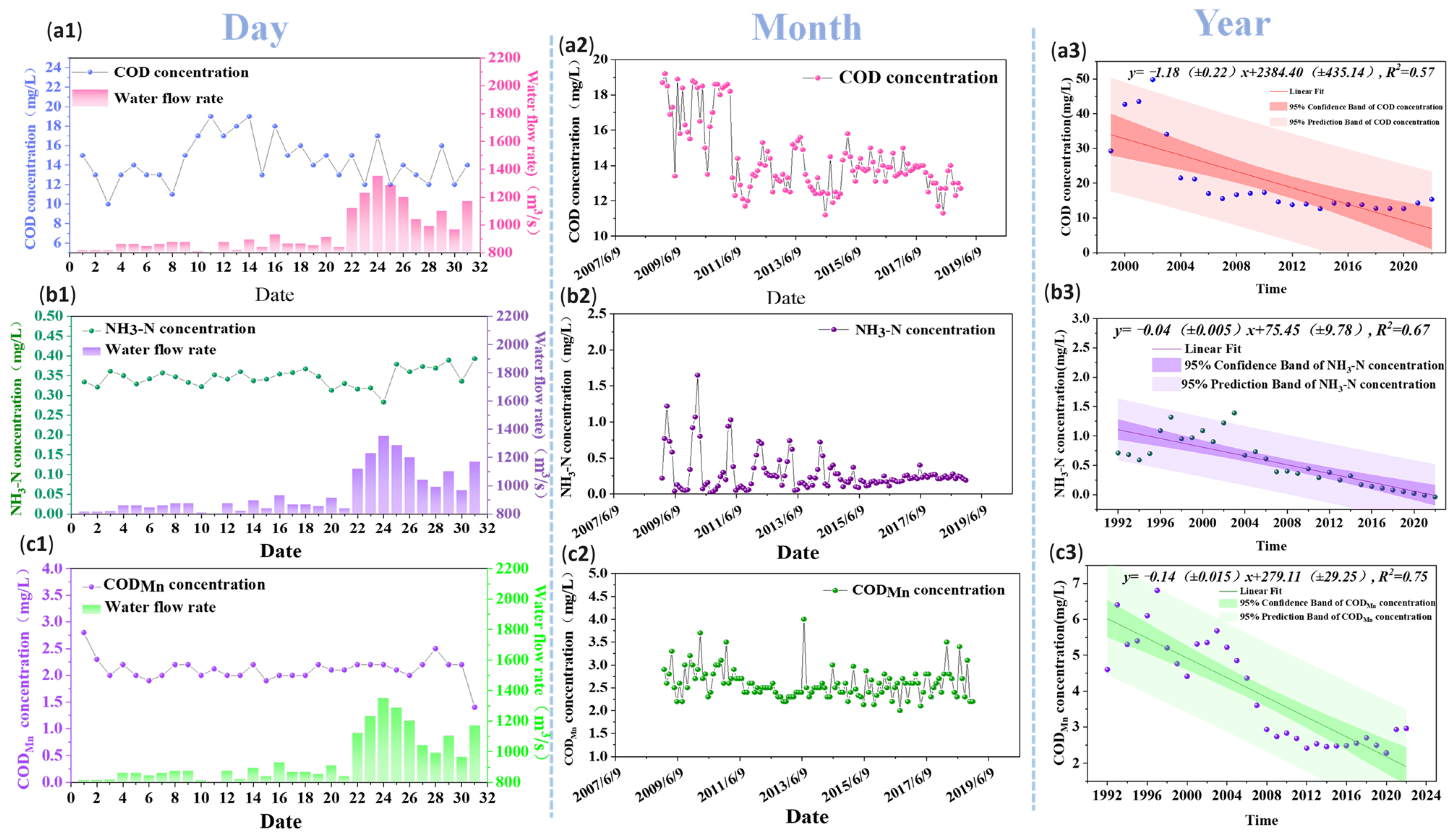
Disclaimer/Publisher’s Note: The statements, opinions and data contained in all publications are solely those of the individual author(s) and contributor(s) and not of MDPI and/or the editor(s). MDPI and/or the editor(s) disclaim responsibility for any injury to people or property resulting from any ideas, methods, instructions or products referred to in the content. |
© 2024 by the authors. Licensee MDPI, Basel, Switzerland. This article is an open access article distributed under the terms and conditions of the Creative Commons Attribution (CC BY) license (https://creativecommons.org/licenses/by/4.0/).
Share and Cite
Yu, Z.; Sun, X.; Yan, L.; Yu, S.; Li, Y.; Jin, H. Analysis of the Water Quality Status and Its Historical Evolution Trend in the Mainstream and Major Tributaries of the Yellow River Basin. Water 2024, 16, 2413. https://doi.org/10.3390/w16172413
Yu Z, Sun X, Yan L, Yu S, Li Y, Jin H. Analysis of the Water Quality Status and Its Historical Evolution Trend in the Mainstream and Major Tributaries of the Yellow River Basin. Water. 2024; 16(17):2413. https://doi.org/10.3390/w16172413
Chicago/Turabian StyleYu, Zhenzhen, Xiaojuan Sun, Li Yan, Shengde Yu, Yong Li, and Huijiao Jin. 2024. "Analysis of the Water Quality Status and Its Historical Evolution Trend in the Mainstream and Major Tributaries of the Yellow River Basin" Water 16, no. 17: 2413. https://doi.org/10.3390/w16172413
APA StyleYu, Z., Sun, X., Yan, L., Yu, S., Li, Y., & Jin, H. (2024). Analysis of the Water Quality Status and Its Historical Evolution Trend in the Mainstream and Major Tributaries of the Yellow River Basin. Water, 16(17), 2413. https://doi.org/10.3390/w16172413





